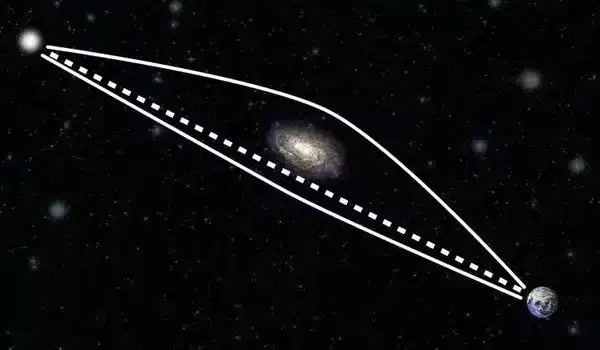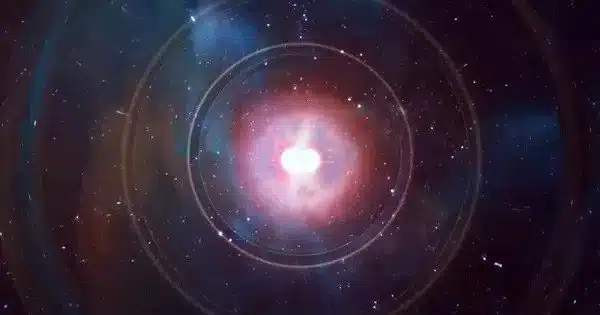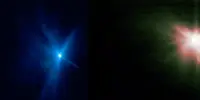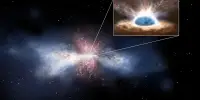Lensed gravitational waves are an intriguing astrophysics concept that has the potential to provide a novel technique to monitor cosmic expansion and acquire insights into the nature of the universe. Gravitational waves are disturbances in the fabric of spacetime created by the acceleration of heavy objects, as predicted by Albert Einstein’s theory of general relativity. These waves contain data about the dynamics of the objects that generated them, such as merging black holes or neutron stars.
We’ve known for almost a century that the cosmos is expanding. However, it is unclear how swiftly celestial objects are receding from one another. Measuring the rate at which things move away from each other across large distances is no easy task. Since the discovery of cosmic expansion, its rate has been measured and re-measured with increasing precision, with some of the most recent values ranging from 67.4 to 76.5 kilometers per second per megaparsec, which relates recession velocity (in kilometers per second) to distance (in megaparsecs).
The discrepancy between different measurements of cosmic expansion is called the “Hubble tension.” Some have called it a crisis in cosmology. But for UC Santa Barbara theoretical astrophysicist Tejaswi Venumadhav Nerella and colleagues at the Tata Institute of Fundamental Research in Bangalore, India, and the Inter-University Center for Astronomy and Astrophysics in Pune, India, it is an exciting time.
We understand very well just how sensitive gravitational wave detectors are, and there are no astrophysical sources of confusion, so we can properly account for what gets into our catalog of events. The new method has sources of error that are complementary to those of existing methods, which makes it a good discriminator.
Tejaswi Venumadhav Nerella
Detectors have greatly improved since the first detection of gravitational waves in 2015, and are expected to provide a rich haul of signals in the coming years. Nerella and his colleagues have devised a way for using these signals to calculate the expansion of the cosmos, which could help to resolve the argument once and for all. “A major scientific goal of future detectors will be to deliver a comprehensive catalog of gravitational wave events, and this will be a completely novel use of the remarkable dataset,” explained Nerella, co-author of a report published in Physical Review Letters.
Measurements of the cosmic expansion rate boil down to velocity and distance. Astronomers use two kinds of methods to measure distances: the first start with objects with a known length (“standard rulers”) and look at how big they appear in the sky. These “objects” are features in cosmic background radiation, or in the distribution of galaxies in the universe.
A second class of approaches begins with objects of known luminosity (“standard candles”) and uses their apparent brightness to calculate their distances from Earth. These distances are linked to those of further brilliant objects, and so on, forming a chain of measuring systems known as the “cosmic distance ladder.” In addition, gravitational waves can aid in the measurement of cosmic expansion since the energy generated by the collision of neutron stars or black holes can be utilized to calculate the distance to these objects.

The method that Nerella and his co-authors propose belongs to the second class but uses gravitational lensing. This is a phenomenon that occurs when massive objects warp spacetime, and bend waves of all kinds that travel near the objects. In rare cases, lensing can produce multiple copies of the same gravitational wave signal that reach Earth at different times — the delays between the signals for a population of multiple imaged events can be used to calculate the universe’s expansion rate, according to the researchers.
“We understand very well just how sensitive gravitational wave detectors are, and there are no astrophysical sources of confusion, so we can properly account for what gets into our catalog of events,” Nerella went on to say. “The new method has sources of error that are complementary to those of existing methods, which makes it a good discriminator.”
The generators of these signals would be binary black holes, which are systems of two black holes that circle each other and eventually merge, releasing huge amounts of energy in the form of gravitational waves. We haven’t yet identified heavily lensed examples of these signals, but the next generation of ground-based detectors is projected to have the appropriate sensitivity.
“We expect to see the first observations of lensed gravitational waves in the next few years,” research co-author Parameswaran Ajith stated. Future detectors should also be able to view further into space and identify weaker signals.
The authors anticipate that these upgraded detectors will begin their search for merging black holes within the next decade. They expect to capture signals from a few million black hole couples, with a small fraction (about 10,000) appearing several times in the same detector due to gravitational lensing. The Hubble expansion rate is encoded by the distribution of the delays between these recurrent appearances.
Unlike prior methods of measurement, this method, according to lead scientist Souvik Jana, does not rely on knowing the exact locations or distances to these binary black holes. The only prerequisite is to correctly identify a large enough number of these lensed signals. The researchers go on to say that studies of lensed gravitational waves can even shed light on other cosmological concerns, such as the nature of the unseen dark matter that accounts for much of the universe’s energy content.















